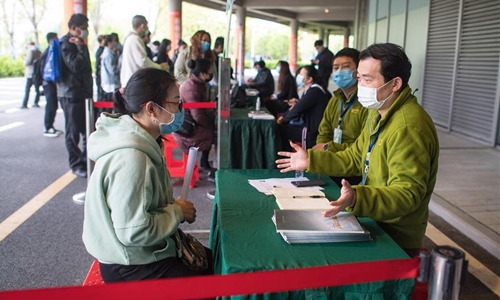Wuhan’s target of full return to production by end April overly optimistic, say experts
By Zhao Yusha in Wuhan Source:Global Times Published: 2020/4/26 15:43:40

A staff member from a company communicates with a job applicant at an on-site job fair in Wuhan, central China's Hubei Province, April 21, 2020. An on-site job fair was held in Wuhan on Tuesday with strict epidemic prevention measures. Over 1,600 job vacancies from more than 40 enterprises were offered to applicants, involving a variety of industries like food, pharmaceuticals, logistics, manufacturing, garment, agriculture, etc. To offset COVID-19's impact on the job market, China has taken measures to ensure employment and promote work resumption, according to the Ministry of Human Resources and Social Security (MHRSS). Photo:Xinhua
The Wuhan government has set the goal of achieving 100 percent production resumption by the end of April, while the large number of closed shops and struggling small- and medium-sized enterprises (SMEs) said that goal maybe too optimistic. Local experts suggest that a full-scale production resumption can only occur when life in the virus ravaged city has totally returned to normal, by mid-May in the best case scenario.
The goal was set during a Saturday telephone conference held by the Wuhan government, in which they described the target as a "full scale deadly strike" against the economic impact caused by the coronavirus on the city.
The drop in added value and sales of Wuhan's large-scale industries reached 19.1 and 15.9 percent respectively in March, while loan balance of RMB and foreign currencies in financial institutes increased by 12.5 percent in late March, according to the conference.
After the lockdown lift on April 8, the Wuhan government rolled out a slew of measures to stimulate consumption and speed up the city's resumption of production, which include disbursing 500 million yuan ($71 million) worth of "consumption coupons" for residents, and unveiling an array of supportive measures to help keep SMEs afloat.
Although a 100 percent return to production is the most desirable outcome, Wuhan's situation suggests the reality does not match the wishes of the local government.
At least 70 percent of shops in the city remained closed when the Global Times reporters went to visit. Entertainment venues, such as cinemas and travel companies, have remained close to the public.
Restaurant owner Zhu Ping told the Global Times that she would only open when the city government allows customers to dine in. "I opened for two days. No costumers come in to eat, as it was forbidden, and I got only two or three orders from the online delivery platform. The cost of opening was much more than I earn each day, so I closed it again."
Zhu's concern was shared by many Wuhan SMEs, who fac series problems in resuming production, including negotiating house rent exemptions with landlords and fewer orders and customers to keep their business going. Some simply went bankrupt during the months-long lockdown and could not afford to reopen.
They believed the government's generous measures aimed at relieving the pressure on SMEs, such as a 20-billion-yuan special fund to support business, have thresholds that many of them cannot meet, and it took time for such measures to be implemented.
"The grass grows and the horse starves. We cannot afford to wait," said Zhu.
Dong Dengxin, director of the Finance and Securities Institute at Wuhan University of Science and Technology, told the Global Times that the outbreak has had little impact on State-owned and large corporations, as some of them did not suspend production activities during the lockdown; they also wasted no time in starting operations when the virus in the city began to recede.
It is the small businesses and self-employed entrepreneurs, such as consumer-oriented catering businesses and small processing plants, that have been under enormous pressure to restart their business, he noted.
Dong estimated that these businesses' recovery largely relies on the resuscitation of consumption in Wuhan, which has a population of more than 11 million people. He estimated that in the most optimistic scenario, their businesses will be boosted once life in Wuhan returns to normal in early May, when schools gradually open.
Posted in: SOCIETY